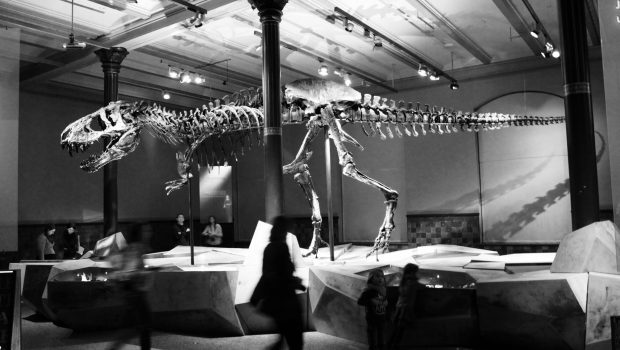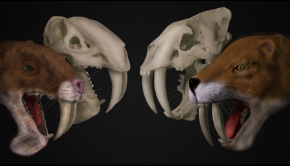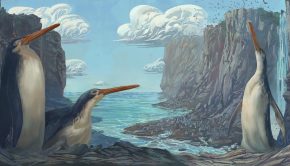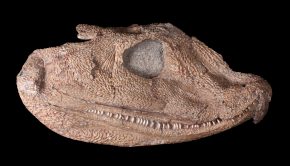Need for Speed: Cretaceous Drift
“Must go faster!” yells Dr Ian Malcolm, as his mangled, yet rather toned, body was hauled away in the Jurassic Park jeep, his lovely hair swaying in the wind as they fled from the Tyrannosaur paddock, chased by a particularly hungry and particularly nimble T. rex. He needn’t have worried.
Today’s news brings with it a novel attempt to calculate the king of the tyrant lizard’s preferred gait and maximum speeds, combining two established methodologies in the field of biomechanics in order to reduce the uncertainties surrounding the top speeds of this creature. Indeed, previous attempts at calculating the velocity of this exemplar predator have produced a huge range of disparate speeds.
This is of particular importance as much can be inferred in terms of biomechanics, behaviour and the way we represent large terrestrial predators in the media. The Jurassic Park scene is an example of just that: we have a 6-7 tonne giant keeping up with a jeep travelling at over 40mph as the vehicle hits fourth gear.
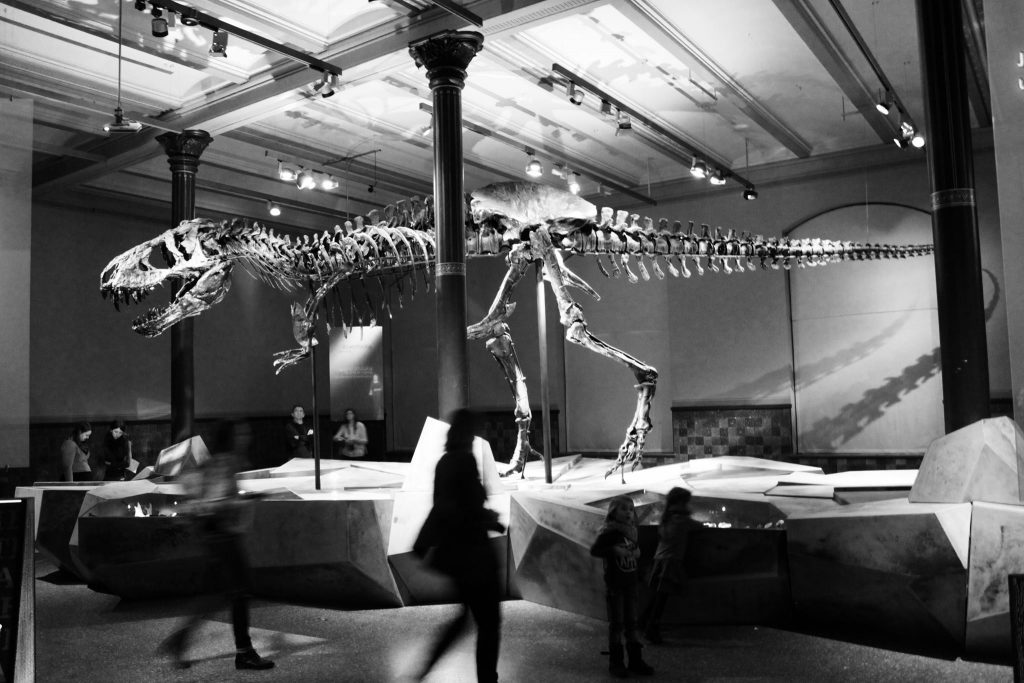
Fig. 1. Qualitative anatomical characters indicate that T.rex could hit fast running speeds, however quantitative biomechanical data remains skeptical. Credit: Chris Barker.
Dinosaurs as a whole had developed structures around the hip area in order to accommodate their erect stance: the acetabulum (the hole in the hip that accommodates the femur) has a distinct bony ridge (the supra-acetabular ridge), which helps transmit the weight and force of the animal vertically, for example. However, whilst bone is strong, there are limits to what it can withstand.
William Sellers and colleagues from various institutions from the UK and US looked to find a consensus on T. rex’s top speed, and put an end to a one hundred year old debate as to whether it was a fast predator.
Anatomy vs Biomechanics
Tyrannosaurs are known for their relatively longer limbs compared to other theropods, with the middle metatarsus pinched in between the surrounding two (a condition known as arctometatarsalian), a trait shared with other fast running coelurosaurs (ornithomimosaurs, troodontids), which helped stablise the foot. The femur is shorter than the distal portions of the leg (tibia/fibula and toes) in all three of the aforementioned organisms, a feature classically associated with fast runners. In addition, the caudofemoralis muscle, the large tail muscle that attaches to the back of the femur, is absolutely huge in Tyrannosaursus, accounting for 58% of the total tail mass. This is significant as the caudofemoralis acts as an important limb retractor in dinosaurs- the larger the muscle, the more force generated.
However, the Sellers and colleagues note that quantitative biomechanical data previously recorded for tyrannosaurs reduce its top speed, despite qualitative anatomical data, including the above, indicating significant athleticism despite its bulk.
The advantage of biomechanics, they note, is the incorporation of anatomical characters with soft tissue parameters, typically derived from computer models or minimum-maximum values in living organisms. However, there is an issue: soft tissue is hardly ever preserved in the fossil record, and must therefore be estimated for animals such as dinosaurs, a notable cause for performance imprecision.
How does one get around this issue? Sellers and the team looked into biomechanical parameters they could calculate, such as bone loading (the mechanical forces applied to bone, like compression or torsion), and combined it with multibody dynamics (MBDA), a form of virtual robotics, whose strength lies in the ability to compute forms of loading in a changing environment, such as during a run.
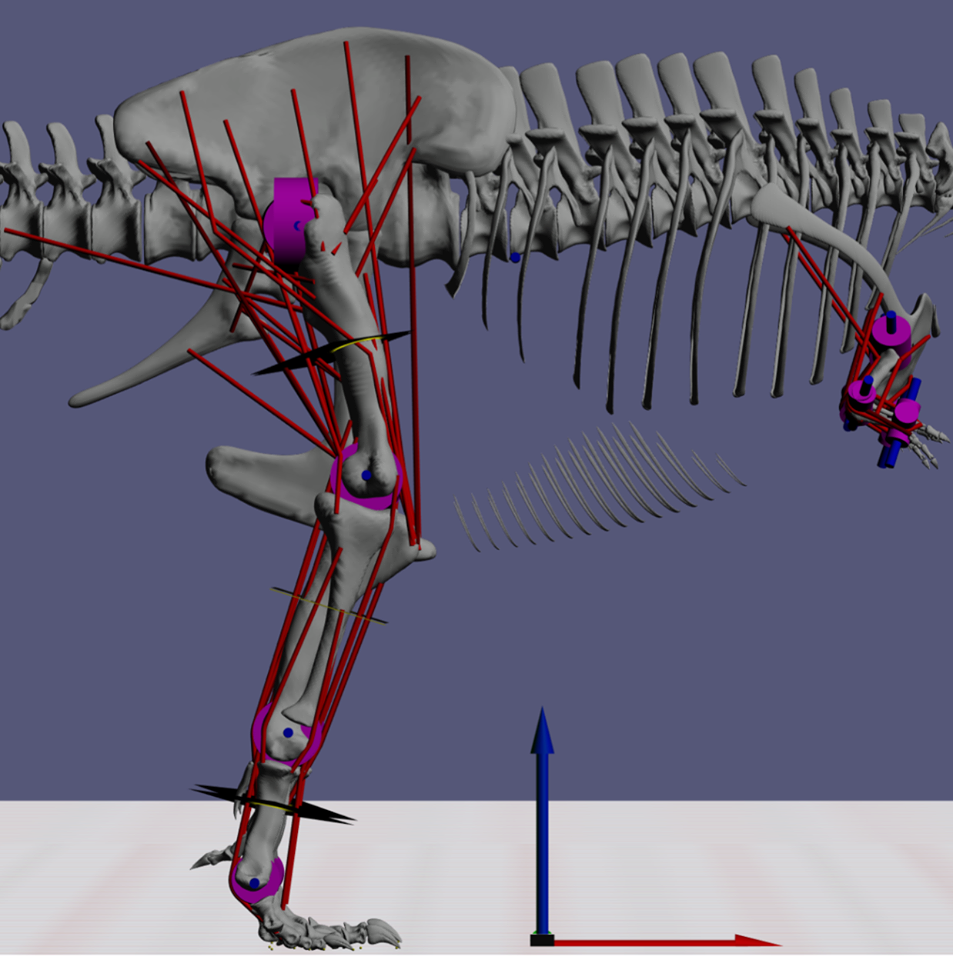
Fig. 2. Reconstruction of the Tyrannosaurus hind limb, with muscle paths in red and joints in blue. Note the large caudofemoralis muscle we mentioned earlier, attaching itself to the back of the femur. Credit: Sellers et al, 2017.
Bone has an ability to absorb stresses of up to 100 MPa, which in Tyrannosaurus equates to a fast walking gait. Upon entering a true running gait (such that both legs are off the ground during the aerial phase), the forces experienced in the limbs of T. rex become unacceptable, exceeding the maximum value. The bones would simply shatter as the leg impacted the ground following the aerial phase of running. As a result, a seemingly more leisurely 20kph (12mph) suited the animal, comparable to a jog for us perhaps not-so-puny humans.
Walking has it’s advantage due to the fact that both legs are on the ground and supporting the body at a given time, which although reduces the speed of the animal, does divide the load generated by two, via both legs.
What does this mean for tyrannosaur hunting behaviour?
For starters, Ian Malcolm would have had a more relaxing car ride back to Jurassic Park headquarters. As for prey pursuit, it appears that adult Tyrannosaurus are indeed specialized for big game hunting, not only due to their monstrous bone-crushing bite, but due to the fact that its multi-tonne prey would most likely be under the same biomechanical constraints. T. rex didn’t need to be fast, it just had to out-maneuver already hefty prey, like Triceratops. Abush-type predation thus seems the most likely method of attack. Interestingly, the long limbs we alluded to earlier, often linked to cursoriality, would have actually limited it to the walking gait, but would have maximized its walking speed.
The authors conclude that a similar methodology could be used across tyrannosaur ontogeny, which would be interesting as it could hint at difference in predation styles between the smaller individuals and the multi-tonne adults. In addition, I feel it would be of interest to analyse not only the contemporaneous herbivores, in order to assess maximum locomotion speeds (could they escape a T. rex attack in a flat out chase?), but also those of Dakotaraptor, the large Late Cretaceous maniraptoran, as these appear to be built for speed and would have directly competed with juvenile tyrannosaurs for food.
 Blog post by Chris Barker. Chris studied Vertebrate Palaeontology at the University of Southampton and has a fondness for all things archosaur.
Blog post by Chris Barker. Chris studied Vertebrate Palaeontology at the University of Southampton and has a fondness for all things archosaur.

